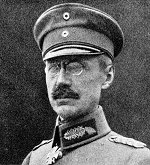General Command 51
The Generalkommando 51 was a large unit of the army of the German Empire in the First World War .
structure
General Command 51 was a General Command z. b. V. (General Command for Special Use). These emerged from 1916 and were purely command posts; the military units were assigned to them as required.
history
On August 27, 1916, Lieutenant General Albert von Berrer was appointed leader of the newly formed General Command (e.g. V.) No. 51, which was particularly successful during the Kerensky offensive in July 1917 and, as part of the Winckler army group, in the capture of Tarnopol was involved. In the second meeting of the "Winckler" group at Zloczow , the 5th and 22nd divisions were subordinate to the "Berrer" group . Behind it, the 42nd Division and the 92nd Division assembled to push as a reserve.
Then General Command 51 was moved to the northernmost section of the Eastern Front and took part in the Battle of Riga . As part of the 8th Army after crossing the Daugava River, it commanded the center of the assault group set up on Riga . On September 2, 1917, the 1st Guard Division , the 14th Bavarian Division , followed by the 20th Division and the 75th Reserve Division in the 2nd meeting were subordinated .
General Command 51 was transferred to Italy on the Isonzo Front in September 1917 and added to General Otto von Below's newly formed 14th Army . The groups called “Berrer” comprised the 200th Infantry Division in the southern part of the Tolmein bridgehead, followed by the 26th Infantry Division (1st Royal Württembergische) . General Berrer was killed in the Twelfth Battle of Isonzo while advancing on Udine . His successor was General of the Infantry Eberhard von Hofacker .
At the beginning of 1918, General Command 51 with the 14th Army (from February 1918 AOK 17 ) was transferred to the Western Front. During the German Michael attack on March 21, the General Command formed the left wing of the 2nd Army in the area north of Bellenglise with the 19th , 109th , 208th and the Guard Replacement Divisions and kept up with the southern attacking 18th Army . Army .
During the battle of Amiens on August 8, 1918, the " Black Day of the German Army ", the corps was together with the XI. Army Corps in the main field of attack of the British 4th Army. While the south wing of the General Command, the 192nd Division and the 14th Bavarian Division still held out against the French at Moreuil , the northern section collapsed. The breakthrough of the Australians and Canadians in the 13th , 41st , 117th and 225th divisions on both sides of Villers-Bretonneux reached Harbonnières and initiated the German retreat. On August 22nd, Lieutenant General Hans von Below was entrusted with the management of General Command 51. Below commanded the general command in the battle of Péronne , the defensive battle between Cambrai and St. Quentin as well as in the retreat battles in front of and in the Hermann position and in front of the Antwerp - Maas position.
After the Armistice of Compiègne Below led his troops back home.
Commanding general
| Rank | Surname | date |
|---|---|---|
| Lieutenant General | Albert von Berrer | August 27, 1916 to October 28, 1917 |
| Lieutenant General | Eberhard von Hofacker | November 3, 1917 to August 23, 1918 |
| Lieutenant General | Hans von Below | August 23, 1918 until the end of the war |
Individual evidence
- ^ Reichsarchiv (ed.): The World War 1914-1918. Volume XIII, ES Mittler & Sohn, Berlin 1942, p. 195.


